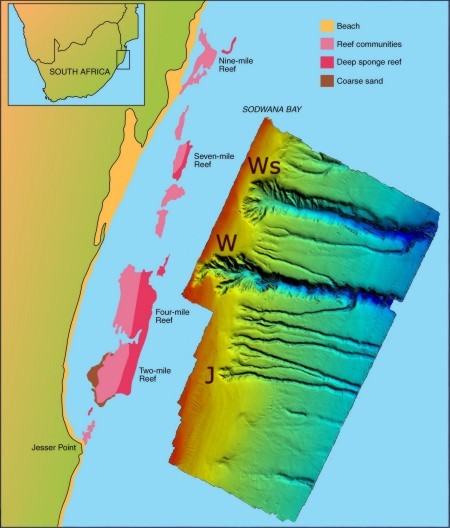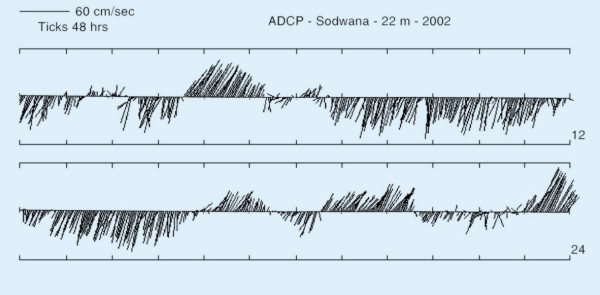Maputaland (Sodwana)
Dowload the PDF of this lesson by clicking here
 |
The shelf off Sodwana is extremely narrow. The major oceanographic influence is the Agulhas Current. The region north of Cape Vidal is characterized by coral reefs established on sandstone outcrops. These are the only coral reefs in South Africa. Coelacanths have recently been found in canyons present along the shelf edge. (refer to Fig. 1) Very little oceanographic research has been done in this area. It has been suggested that certain processes are occurring here, such as warm water pulses (formed in tropical regions) travelling southward, shelf edge upwelling, inshore current reversal and the offshore migration of the Agulhas Current. Complicated variability on intra- and inter annual time-scales occurs in this region. Long-term monitoring of corals is taking place off Sodwana, which included the recording of a recent coral bleaching event. It is believed that this event was caused as a result of oceanic warming which began in 1998. From regional data it can be seen that since the 1950's, sea surface temperatures have been increasing. Continuous heating (global warming) has serious implications for the biodiversity of corals, and more dramatic coral bleaching events can be expected (Celliers and Schleyer, 2002). |
|
Figure 1 |
Recent data obtained in the area included current measurements (refer to Fig. 2). These showed a dominant flow south-westward as would be expected. Occasionally there is a complete reversal in this current, and it flows in a north-eastward direction. Four mechanisms may be responsible for these reversals, namely (1) wind, (2) the passing of a Natal pulse, (3) a southward extension of the Delagoa cyclonic gyre or (4) coastal trapped waves. These mechanisms are still being researched (Shelf Oceanography of Sodwana - Relevance to long-term monitoring, coral reef ecosystems and MPAs, Data Report No. 2).
 |
|
Figure 2 |
CLASSIC PAPER
Marine and Coastal Management, (2002). Shelf Oceanography of Sodwana - Relevance to long-term monitoring, coral reef ecosystems and MPAs, Data Report No. 2
Bibliography
- Celliers, L. and Schleyer, M. H. (2002). Coral bleaching on high-latitude marginal reefs at Sodwana Bay, South Africa. Marine Pollution Bulletin, 44, 1380-1387.



